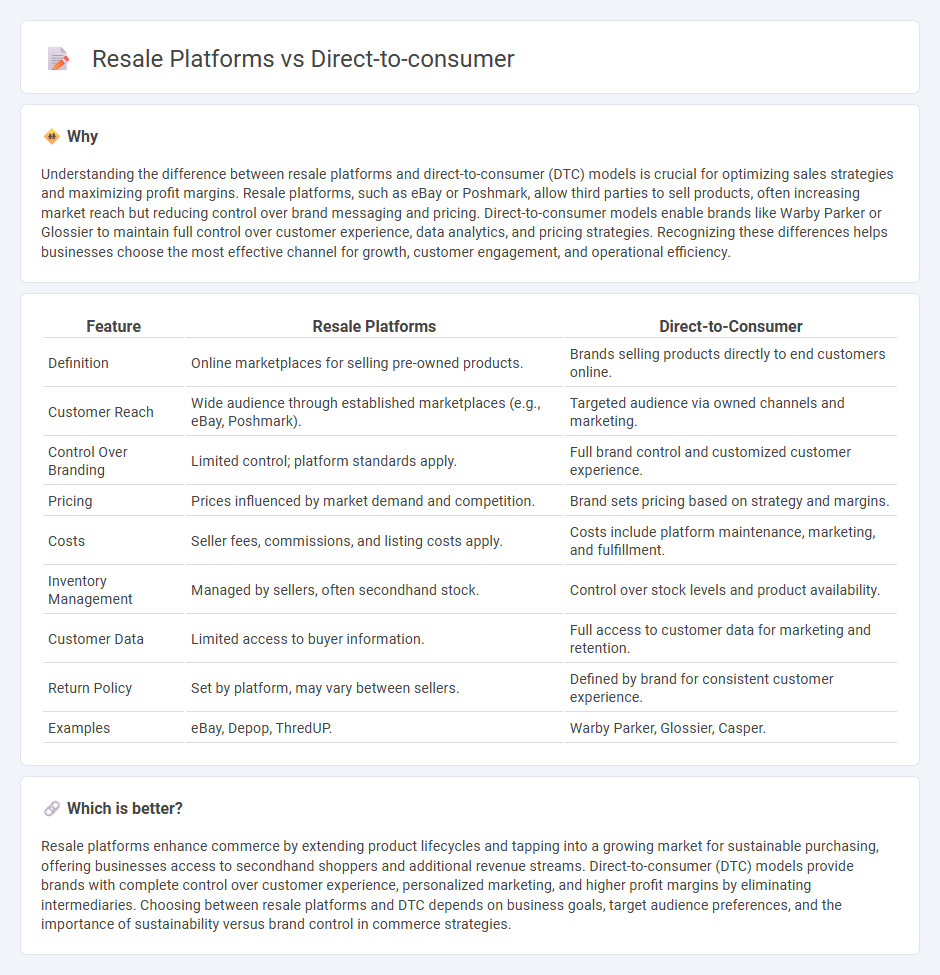
Resale platforms offer businesses a channel to reach a wider audience by enabling the sale of secondhand or pre-owned goods, often attracting budget-conscious and environmentally aware consumers. Direct-to-consumer (DTC) models eliminate intermediaries, allowing brands to maintain control over customer experience, pricing, and data collection, boosting profit margins and fostering brand loyalty. Explore the advantages and challenges of resale platforms versus direct-to-consumer strategies to optimize your commerce approach.
Why it is important
Understanding the difference between resale platforms and direct-to-consumer (DTC) models is crucial for optimizing sales strategies and maximizing profit margins. Resale platforms, such as eBay or Poshmark, allow third parties to sell products, often increasing market reach but reducing control over brand messaging and pricing. Direct-to-consumer models enable brands like Warby Parker or Glossier to maintain full control over customer experience, data analytics, and pricing strategies. Recognizing these differences helps businesses choose the most effective channel for growth, customer engagement, and operational efficiency.
Comparison Table
| Feature | Resale Platforms | Direct-to-Consumer |
|---|---|---|
| Definition | Online marketplaces for selling pre-owned products. | Brands selling products directly to end customers online. |
| Customer Reach | Wide audience through established marketplaces (e.g., eBay, Poshmark). | Targeted audience via owned channels and marketing. |
| Control Over Branding | Limited control; platform standards apply. | Full brand control and customized customer experience. |
| Pricing | Prices influenced by market demand and competition. | Brand sets pricing based on strategy and margins. |
| Costs | Seller fees, commissions, and listing costs apply. | Costs include platform maintenance, marketing, and fulfillment. |
| Inventory Management | Managed by sellers, often secondhand stock. | Control over stock levels and product availability. |
| Customer Data | Limited access to buyer information. | Full access to customer data for marketing and retention. |
| Return Policy | Set by platform, may vary between sellers. | Defined by brand for consistent customer experience. |
| Examples | eBay, Depop, ThredUP. | Warby Parker, Glossier, Casper. |
Which is better?
Resale platforms enhance commerce by extending product lifecycles and tapping into a growing market for sustainable purchasing, offering businesses access to secondhand shoppers and additional revenue streams. Direct-to-consumer (DTC) models provide brands with complete control over customer experience, personalized marketing, and higher profit margins by eliminating intermediaries. Choosing between resale platforms and DTC depends on business goals, target audience preferences, and the importance of sustainability versus brand control in commerce strategies.
Connection
Resale platforms and direct-to-consumer (DTC) models are interconnected through the shift in consumer behavior towards sustainability and personalized shopping experiences. DTC brands often leverage resale platforms to extend product lifecycle, enhance brand loyalty, and tap into secondary markets with authenticated, pre-owned goods. This synergy reduces waste, maximizes customer lifetime value, and aligns with the growing demand for circular commerce.
Key Terms
Supply Chain
Direct-to-consumer (DTC) platforms streamline the supply chain by eliminating intermediaries, resulting in faster delivery times and greater control over inventory management. Resale platforms involve multiple supply chain stages, including verification, refurbishment, and logistics, which can extend turnaround times but increase product accessibility. Explore the nuances of supply chain strategies for both models to optimize your business operations.
Pricing Strategy
Direct-to-consumer (D2C) platforms offer brands full control over pricing strategy, allowing for dynamic pricing, promotional flexibility, and elimination of third-party margins, resulting in potentially higher profit margins. Resale platforms often drive prices through market demand, competition, and standardized fees, which can compress seller margins but offer access to a broader customer base. Explore detailed comparisons and strategies to optimize pricing across these platforms for maximum profitability.
Customer Ownership
Direct-to-consumer (DTC) platforms allow brands to maintain complete customer ownership, enabling personalized marketing, data collection, and stronger brand loyalty. In contrast, resale platforms control the customer relationship, limiting access to consumer data and communication, which can weaken brand influence. Explore how optimizing customer ownership strategies can enhance your business growth.
Source and External Links
Direct-to-consumer - Wikipedia - Direct-to-consumer (DTC or D2C) is a business model where brands sell products directly to customers, bypassing third-party retailers or wholesalers, mostly via online channels, resulting in significant marketplace growth, such as over $128 billion in U.S. e-commerce sales in 2021.
Direct to Consumer (D2C) Guide | Salesforce US - D2C means brands sell products straight to end users rather than through retail partners, with digital commerce channels allowing brands to grow direct sales complementing traditional retail, and D2C sales expected to exceed $200 billion by 2024.
What Is Direct-to-Consumer? Everything You Need To Know (2024) - DTC is a retail model where brands sell directly to customers via digital channels, offering control over marketing, fulfillment, customer data, and relationships, often focusing on niche products and customer experience over mass retail presence.
 dowidth.com
dowidth.com